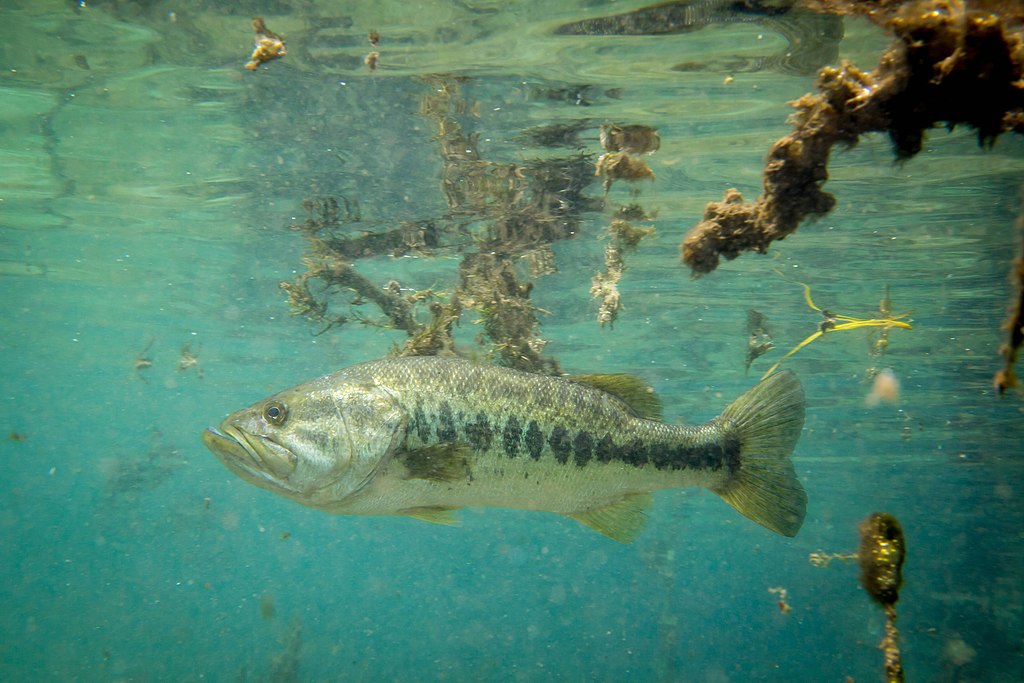
Largemouth Bass
Scientific Name: Micropterus salmoides
Also known as: Black Bass, Green Bass, Bigmouth, Largemouth, Bucketmouth
General Description
The largemouth bass is one of North America’s most popular and sought-after sport fish. Known for its aggressive fighting ability and distinctive appearance, the largemouth bass features a large, wide mouth that extends past its eyes, hence its name. Typically greenish in color, their bodies can range from light olive to a dark green, with a characteristic dark, horizontal stripe running from the gills to the tail. Their bellies are generally lighter in color, ranging from white to yellowish hues. Largemouth bass are members of the sunfish family and are one of the largest species within this group, often reaching sizes of up to 10-12 pounds, with trophy catches exceeding 20 pounds in rare instances.
These bass are known for their predatory behavior, making them a favorite target for anglers due to their size and tenacity. They are primarily carnivorous and feed on small fish, insects, and crustaceans. Largemouth bass can be found in various water conditions, including clear, turbid, still, and flowing waters. They are generally found in areas with abundant cover, like submerged rocks, aquatic plants, and fallen timber, where they can ambush prey.
Where to Find Them
Largemouth bass are widely distributed across North America, ranging from southern Canada to northern Mexico. They thrive in a variety of freshwater habitats, including lakes, ponds, rivers, reservoirs, and marshes. These fish prefer warm waters, with optimal temperatures between 65-75°F, and they tend to stay in shallow waters during spring and summer, especially during their spawning season.
Largemouth bass are most commonly found near structures like submerged rocks, weeds, fallen trees, and drop-offs, which provide both shelter and hunting grounds for these predatory fish. They often hide in the shadows of overhanging trees or submerged vegetation, waiting to ambush passing prey. During the spring, largemouth bass move closer to the shore to spawn, making them easier to target.
In the summer months, bass retreat to deeper waters, where they seek cooler temperatures. During the fall, they may move back into shallower waters as they prepare for the colder winter months. While they can adapt to different types of water, largemouth bass prefer lakes and reservoirs with abundant plant life, as it provides ample hiding places and hunting grounds. Rivers and streams with slow to moderate currents are also ideal environments for largemouth bass.
Best Baits
Live Bait Options
- Shad (small to medium)
- Minnows (live, small to medium size)
- Crawfish
- Worms (nightcrawlers, red worms)
- Crickets
Artificial Bait Options
- Soft plastic worms (senkos, curly tails)
- Jigs (rubber or hair jigs)
- Crankbaits (medium to deep diving)
- Spinnerbaits (bladed, chartreuse, or white)
- Topwater lures (poppers, frogs)
Best Fishing Methods
Largemouth bass fishing requires a combination of patience and strategy. One of the most effective methods for catching largemouth bass is by using live bait, such as shad, minnows, or crawfish. Anglers can fish these baits under a bobber, allowing them to drift near the submerged structures where bass are likely to lurk. A bottom rig with live bait can also be effective, especially in deeper waters. For anglers using live worms or minnows, a light to medium tackle setup with a fluorocarbon leader is often ideal for presenting the bait naturally.
When it comes to artificial lures, largemouth bass respond well to soft plastic worms, which can be fished on a Texas rig or Carolina rig. The key is a slow, steady retrieve to mimic the natural movement of prey. Jigs are also effective, especially in areas with dense cover like submerged trees or thick weeds. Crankbaits, especially medium to deep-diving varieties, can be used to reach bass hiding in deeper waters. These lures imitate small fish and allow the angler to explore various depths.
Topwater lures, such as poppers and frogs, can be thrilling to use when bass are feeding near the surface. The strike of a largemouth bass on a topwater lure is often explosive, providing an exciting catch. Using a spinnerbait can be effective when fishing around grassy or weeded areas, as the bait mimics the movement of smaller fish while cutting through the cover. The best time for topwater fishing is typically during dawn and dusk when bass are actively feeding near the surface.
Summary
Fishing for largemouth bass is one of the most rewarding and exciting experiences for anglers. Known for their aggressive strikes and challenging fight, largemouth bass are a staple species for freshwater fishing enthusiasts. They can be caught year-round, with spring and fall being prime seasons, particularly during the spawning period when bass move closer to the shore.
The key to success when targeting largemouth bass lies in understanding their habitat and behavior. During the warmer months, bass are generally found near shallow, submerged structures, while in the summer, they move to deeper waters. Largemouth bass prefer areas with abundant cover like weeds, rocks, and fallen timber, where they can ambush prey. Live bait, such as minnows and crawfish, can be particularly effective, but artificial lures like soft plastic worms, crankbaits, and topwater baits can also produce great results.
Whether you’re fishing from a boat or casting from the shore, largemouth bass offer an exciting and versatile fishing experience. Their willingness to strike various types of bait, from live minnows to artificial jigs, makes them accessible to anglers of all skill levels. With the right techniques and knowledge of their preferred environments, catching a largemouth bass is a rewarding challenge that will keep you coming back for more.


